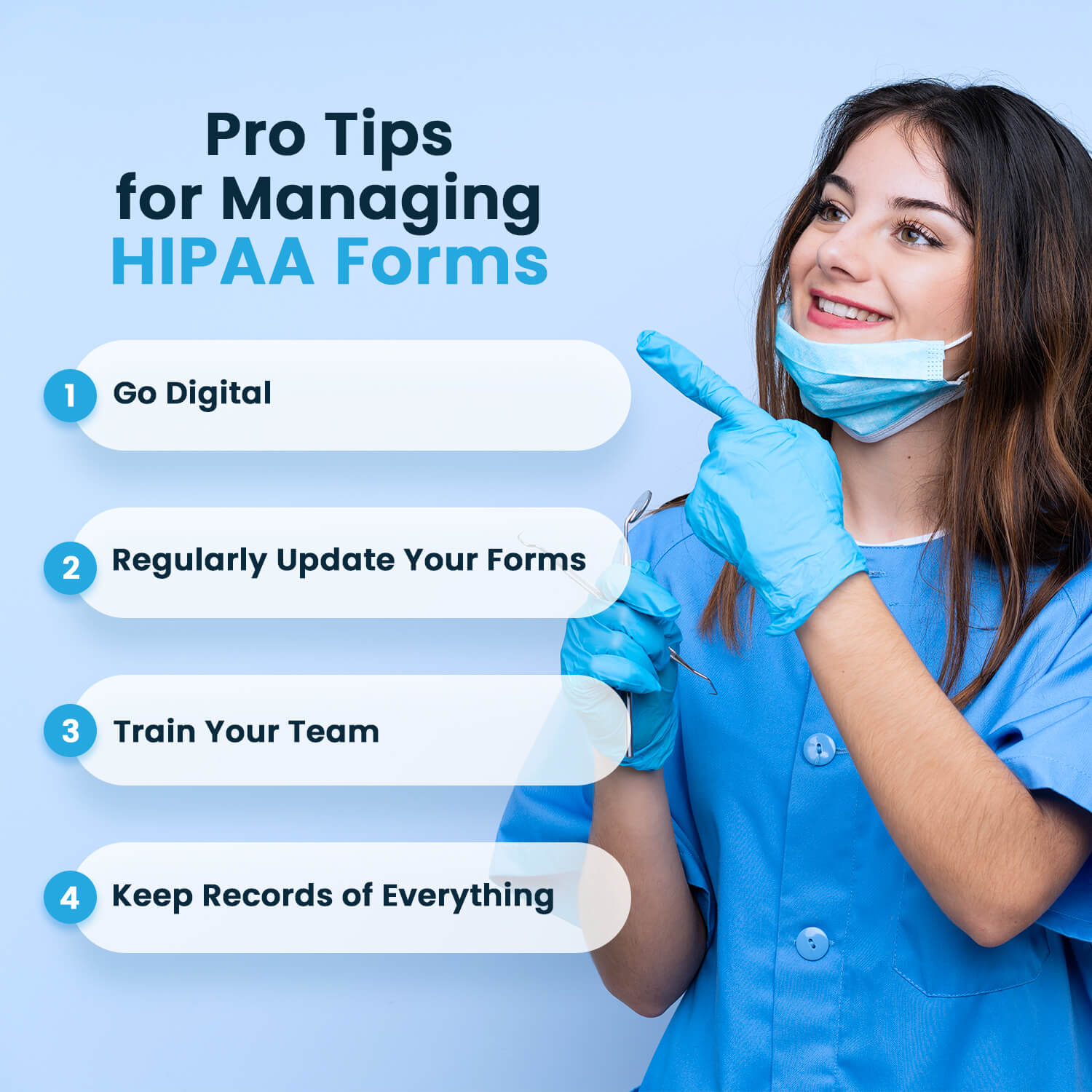Ends in
ends in 106 Days

ends in 106 Days

ends 11 July
HIPAA Compliances For Dental Offices

Running a dental practice comes with its fair share of responsibilities, and staying compliant with HIPAA (Health Insurance Portability and Accountability Act) is one of the big ones. But let’s face it—navigating HIPAA can feel like a maze. From patient privacy to secure record-keeping, there’s a lot to manage, and it all starts with having the right forms in place.
So, if you’re not sure whether your dental office has all its HIPAA forms in a row, don’t worry! We’ve got you covered. This ultimate checklist will break down the must-have HIPAA forms and why they’re so crucial for your practice.
Why HIPAA Compliance Matters for Dental Offices

Before we dive into the forms, let’s talk about why HIPAA compliance is such a big deal. In short, it’s about protecting your patients’ sensitive information. Whether it’s a treatment plan, medical history, or payment details, your patients trust you to keep their info safe.
HIPAA violations can lead to hefty fines (we’re talking thousands or even millions of dollars) and a damaged reputation. But with the right forms and procedures, you can avoid trouble and build trust with your patients.
The Essential HIPAA Forms Checklist
Here’s the rundown of all the HIPAA forms your dental office needs. Don’t worry—it’s not as overwhelming as it sounds!
1. Notice of Privacy Practices (NPP)
This is the one form every dental practice must have. It tells your patients how their health information is used and shared and what their rights are under HIPAA.
What to include:
- How patient info is stored, shared, and protected.
- Patient rights, like accessing their records or requesting corrections.
- Your office’s responsibilities for safeguarding their information.
- When to provide it:
You’ll need to give this form to every new patient and have them sign an acknowledgment that they’ve received it.
2. Patient Consent Form
This form is a must for getting patient permission to use or disclose their information for treatment, payment, or healthcare operations. Think of it as the “green light” for sharing info when necessary.
What to include:
How Beavers & Broomfield Family Dentistry left Weave and boosted efficiency by 40% with Adit Tired of Weave putting your practice on the back burner? When tech issues and poor support began affecting patient experience,...
Schedule a Demo- A clear explanation of why their information might be shared.
- Options for patients to opt-out of certain disclosures.
3. Authorization Form

While the Consent Form covers general use, an Authorization Form is required for specific situations. For example, if a patient wants their records sent to a specialist or insurance company, they’ll need to fill out this form.
What to include:
- Details of the info being shared.
- The name of the person or entity receiving the info.
- A clear expiration date or event for the authorization.
4. Business Associate Agreement (BAA)
If your dental office works with third-party vendors who access patient information (like billing companies or IT support), you need a BAA with each of them. This ensures they’re also following HIPAA regulations.
What to include:
- The vendor’s commitment to protecting patient data.
- Steps they’ll take in the event of a data breach.
5. Breach Notification Form
No one likes to think about worst-case scenarios, but if a data breach happens, you’ll need this form to notify affected patients.
What to include:
- A description of what happened.
- The type of information compromised.
- Steps patients can take to protect themselves.
6. HIPAA Training Acknowledgment
Every member of your team must be trained on HIPAA policies and procedures. After training, they should sign an acknowledgment form to confirm they understand their responsibilities.
What to include:
- Date and details of the training.
- Employee signature.
Pro Tips for Managing HIPAA Forms

Now that you know which forms you need, here are a few tips to make managing them easier:
1. Go Digital
Paper forms are so last decade. Switching to digital forms not only saves you time but also helps ensure patient data is securely stored. Look for software that integrates with your EHR system for seamless record-keeping.
2. Regularly Update Your Forms
HIPAA laws can change, so make it a habit to review and update your forms annually. This ensures you’re always compliant and prepared for audits.
3. Train Your Team
Even the best forms won’t help if your team doesn’t know how to use them. Provide regular HIPAA training sessions and make sure everyone knows how to handle sensitive information.
4. Keep Records of Everything
From signed NPPs to BAAs, keep a record of all your HIPAA forms. You never know when you might need to reference them.
Conclusion
HIPAA compliance might sound intimidating, but it doesn’t have to be. By having the right forms in place and keeping your team informed, you can protect your patients’ privacy and keep your practice running smoothly.
Need help managing your forms or streamlining your processes? Adit has your back with digital tools designed to make compliance a breeze. Reach out to us today to learn more!
more about Adit?
Access a full suite of patient communication tools with Adit! Texting, payments, reviews, & scheduling in one place.
Schedule a DemoAngela is a former English teacher turned marketing content specialist. Over the past 10 years, she’s developed marketing strategies to forge enduring bonds between B2B, B2C and SaaS companies and their clients through holistic education, effective communication, and captivating storytelling that moves audiences to act.
Get a $25 Gift Card when you take a demo
Schedule a Demo
Get a $50 Gift Card
when you take a demo
Looks like you're out of bounds!
Hey there! Your current location falls outside Adit's area of operation. If this is unexpected, try disabling your VPN and refresh your page. For further assistance or to book a live demo, connect with us at 832-225-8865.
December 17 Amazon Demo Promo
Terms and Conditions
Last Updated: December 17, 2025Offer ends December 20, 2025, and is limited to prospective customers who sign an annual agreement before December 31, 2025. Gift card will be emailed to the company owner or established representative within 4 weeks of signing the annual agreement. Offer may not be combined with any other offers and is limited to one (1) gift card per office. Offer is not available to current customers or to prospective customers or individuals that have participated in a Adit demo during the prior six (6) months. Recipient is responsible for all taxes and fees associated with receipt and/or use of the gift card as well as reporting the receipt of the gift card as required under applicable federal and state laws. Adit is not responsible for and will not replace the gift card if it is lost or damaged, is not used within any applicable timeframe, or is misused by the recipient. Adit is not responsible for any injury or damage to persons or property which may be caused, directly or indirectly, in whole or in part, from the recipient’s participation in the promotion or receipt or use of the gift card. Recipient agrees to indemnify, defend and hold harmless Adit from and against any and all claims, expenses, and liabilities (including reasonable attorney’s fees) arising out of or relating to a recipient’s participation in the promotion and/or recipient’s acceptance, use or misuse of the gift card. This offer is sponsored by Adit Communications, Inc. and is in no way sponsored, endorsed or administered by, or associated with Amazon.
Thank You!
We appreciate your interest! Adit AI will be calling you in the next few minutes!
Why Adit?
Cut your software bill by up to 60% when you merge everything your dental office needs to run under one roof.
Centralize Communications
- Phones & TeleMed
- Emails & eFax
- Texting & Reminders
- Call Tracking and more!
Streamline Operations
- Patient Forms
- Online Scheduling
- Payments
- Reviews and more!
Boost Production
- Performance Dashboards
- Morning Huddle
- Claims & Collections
- Patient Profiles
- Follow Up Lists
- Year Over Year Metrics
Acquire More Patients
- Digital Marketing
- Website Design
- SEO
- Google Ads
- Facebook Ads
Ends in

Sign up by filling out the form







